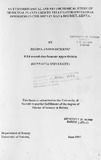| dc.description.abstract | Although the local Siaya people attribute most of the diseases and misfortunes to spirits,
magical and religious practices or animal sacrifices are seldom sought to get rid of
diseases and illnesses, and these do not form part of the curative properties of plants thus
have been ignored. The medicineman, 'ajuoga " was found to play an important role in
traditional medicine in some areas. However, there was a tendency for people to get
herbs from their fellow villagers, close relations or friends as opposed to practitioners
since non-practitioners either charged negligibly or gave their herbals freely.
While the district is reknowned to have a high proportion of learned people, a majority
of the local people themselves have remained rooted to their traditions, customs, beliefs
and practices; Therefore a lot of ethnomedical information can still be obtained from the
area. Recently the area received survey attention through the ethnobotanic works of
Johns and Kokwaro (1991) on herbal remedies and food plants of the region. The plants
mentioned are still quite popular and enjoy a good reputation in their lore.
It was evident that most of the herbal preparations were orally administered, perhaps
because the mode is most convenient and economical. This mode has limitations as it
requires the patient's co-operation yet most of the drugs are very bitter to the taste. The
other limitat-ion is a possibility of incomplete absorption in the stomach and the gastric
irritation which could result from oral administration. Other than oral administration
which was the most popular, rectal and muscular applications of herbs were also cited.
Rectal administration for herbals such as Gynandropsis gynandra has the limitation of
poor patient acceptability but has the advantage of avoiding causing gastric distress and
other limitations of oral use. Muscular applications involving scarifications was also
cited. This was commonly used where gut problems were linked to the 'evil eye'
(sorcery). This mode was least used.
Herbal preparations took the form of powders (ash, dried and ground plant parts),
scarifications, decoctions and concoctions, pastes, pomades, poultices, ointments of ghee
amongst others as described by Kokwaro (1993).
Most of the herbals were harvested in broad day light between morning when dew has
dried up and before sun set. In the wet seasons, plant harvest took place before rather
than after the downpour. It was only in cases of emergency that plants were collected at
otherwise odd hours, for example, night time or after sunset. As a rule, a nursing mother
was not allowed to harvest a herbal for a fellow nursing mother's child, for reasons not
clarified.
Most preparations involved more than one plant source, and any given plant was also
known to treat other diseases in addition, not necessarily the ones reported here, an
added advantage of herbal remedies over western medicines which tend to be specific to
diseases treated. It is as if to say that while treating disease X, the medicament goes
further to treat or ward off others.
It was observed that, most preparations intended to treat stomach aches were often bitter
(e.g. Schkuria pinnata, Tithonia diversifolia, Cassia hildebrandtii, Lantana camara,
Cassia occiden talis, Leonotis nepetifolia etc.). Many interviewees asserted that bitter
medicaments worked best as they quickly repelled causative agents of gut problems.
However, it is only scientific investigation that will be able to confirm or refute such
claims.The most commonly used family was Leguminosae which had 14 plant species
belonging to 10 genera. This was followed by Compositae (Asteraceae) with 11 species
in 11 genera and Labiatae with 10 species in 7 genera. Perhaps Leguminosae took the
lead because of its diversity in the region through its three sub-families which are all
represented. In general, most genera only provided one species each except for Acacia,
Aloe, Capparis, Erythroeoeea, Kedrostis, Hyptis, Plectranthus, Lantana and Ocimum
which provided 2 species each and Cassia which provided 4 species.
In total, 82 plants species spanning across 60 genera in 38 families were documented as
being useful herbals for gastrointestinal disorders in children in the district. Favoured
species included Zanthoxylum ehalybeum, Harrisonia abyssinica, Lannea
schweinfurthii, Kigelia africana, Hyptis pectinata, Euclea divinorum, Plectranthus
barbatus inter alia.
Some most commonly used plants were analysed for the general groups of compounds
they contained, such as flavonoids, anthraquinone, saponins, and alkaloids. A possible
scientific explanation. was given where available for the medicinal plants thus cited. | en |

